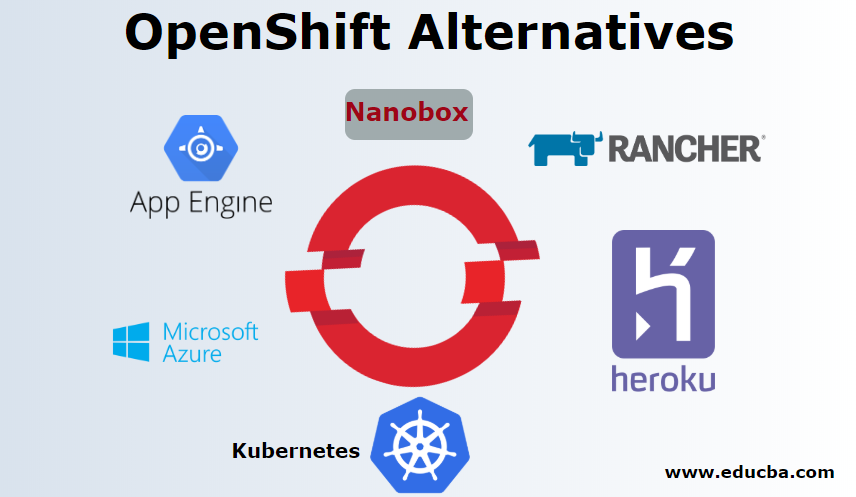Updated May 23, 2023
Overview of OpenShift Alternatives
OpenShift is a free, automated, applications-based (PaaS) platform for Red Hat. OpenShift manages the stack as an application platform in the cloud to concentrate on your technology. The OpenShift platform uses OpenShift Origin, an open-source collection of components, as a service. The OpenShift Container Platform provides a platform for using a Docker-containing system in a government, private or hybrid cloud. In this topic, we are going to learn about OpenShift Alternatives.
Top Alternatives of OpenShift
Here are the top alternatives of OpenShift as follows:
1. Heroku
- Heroku is a cloud application platform for Python, Scala, Rails, Ruby, Node.js, Java, and Clojure web app. All the building, running, and scale you need. Heroku runs almost any language at every level. Integrate and sync Sales-force seamlessly.
- Heroku offers internet app building, running, and scale instruments and services. It allows developers to concentrate on the design and production of compelling applications. Powerful developers platform that allows you to concentrate on creating excellent applications.
- Construct and run your apps. Once you press the source code for your implementation, Heroku prepares it to be executed by recovering your app’s required framework and language-specific dependencies.
2. Kubernetes
- This is another alternative to OpenShift. Kubernetes is a Small Docker Container open-source orchestration scheme. It manages the planning of nodes in a compute cluster and actively manages workloads to guarantee that their state aligns with the intended customers.
- It’s a platform intended with techniques that provide predictability, scalability, and high availabilité to handle the life cycle of containerized apps. As a Kubernetes customer, you can determine how your apps work and how they communicate with other apps or the outside world.
- We can scale up or down your service, make graceful rolling updates, and move from one version to another for testing characteristics or rollback problem deployments. Kubernetes offers interfaces and primitive composable platforms that enable high flexibility, power, and reliability in defining and managing apps.
3. Google App Engine
- Google App Engine offers a free platform in Google-managed data centers that develops and hosts web applications. App Engine provides quick creation and deployment, easy management, equipment, patches, or backups without worrying about, and easy scalability.
- These apps must be written in PHP, Python, Java, and Go, supported by several languages. The Google query language is also necessary, and Google Big Table is used as the database.
- Applications must satisfy these standards, so apps must be created or altered to satisfy the demands with GAE in mind.
4. Rancher
- Docker is excellent for creating a scalable infrastructure. It forces you to isolate your request in reasonable chunks and encourages you to create these parts as stateless services. This is great for high availability and scalability, but it can be hard to manually scale a pure Docker infrastructure.
- The “formal” solutions to these problems are Docker Swarm and Composite – they enable you to create a vast and elastic Docker cluster present to your customer on a single machine. Compose also enables you to scale your request to several cases readily.
- Tutum is a service that contributes to the excellent achievement of those remaining parts. Although with Tutum, you can use your nodes, sometimes your self-hosting service is desirable.
5. Microsoft Azure
- Microsoft Azure is a public cloud application platform. It provides a variety of computer, analytics, storage, and network-based cloud services. Users can choose and scale up fresh apps or operate current apps in the government cloud through these facilities.
- Azure in the Azure Portal classifies services into various categories. The portal provides customers with access to all characteristics and services of Azure. In addition to various Azure characteristics and services, various Azure calculation models exist.
- Each one has its duties and roles. Different models can be used in isolation or combined to create the right basis for your application. Your chosen strategy should be consistent with the issues you attempt to resolve.
6. Nanobox
- The perfect platform for developers is Nanobox. Take on DevOps as your role, so you don’t have it; Nanobox creates, configures, and manages all your infrastructure, so you can concentrate on software rather than configure.
- Create consistent, isolated developing environments that can be shared easily with anybody and used on any host. With the Nanobox dashboard, easy management of manufacturing apps. Using a statistical panel and the streaming and historical log output, you deploy and scale with zero downtime.
7. Cloudify
- Make a smooth cloud transition and automate even the most complicated apps during your whole life with Cloudify. Organize your application to create the entire cloud infrastructure, from computing resources to networks and block storage devices.
- Cloudify then implements your cloud apps. You won’t be in your cloud for one sort or another with Cloudify; use your favorite automation and configuration management tools to install the same application in your data center or the cloud of your choice. Cloudify, regardless of topology or technology, monitors, manages, and scales your request.
Conclusion
Some might feel I am a complete fan of OpenShift, but I enjoy working with the two-OpenShift and Kubernetes. They also enable our containerized applications to be deployed and managed in a manner accessible only to unicorns such as Google. Whatever you choose will make your life more convenient, and your trip to the cloud globe will start.`
Recommended Articles
This is a guide to OpenShift Alternatives. Here we discuss the basic concept and top alternatives of OpenShift. You may also have a look at the following articles to learn more –



